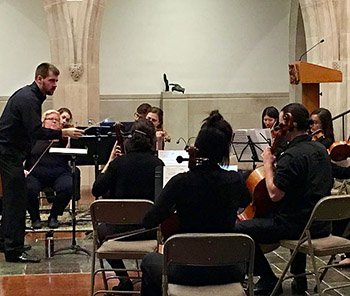by David Kulma

To discern that Ellis has done something special with Earth and Air, one only had to listen to their limpid and powerful performance of the Adagietto from Mahler’s Symphony No. 5. In a chamber format with 17 strings plus harp, this gorgeous, heart-tugging music look on a clarity — especially against Grace Roepke’s wonderful harp backdrop — that’s not possible with many full orchestral string sections. Ellis and his players made one feel as if suspended in air.
Coleridge-Taylor was a well known composer in Britain a hundred years ago. He wrote a well-loved cantata trilogy on Longfellow’s The Song of Hiawatha, but his early death at 37 — and his dark skin — kept him from achieving fame in the U.S. His Four Novelleten from 1903 is a delightful, light work that reminds one of Elgar and Richard Strauss with its shapely arpeggios and lush harmonies.
The first and third movements are waltzes, each featuring memorable contrasting sections. The opening one featured sweeping lines in a major key, while the third is in a darkened, slower-moving minor. Earth and Air played the pleasant Grieg-like second movement with a forward-moving, medium tempo, while the finale featured a vigorous opening and a teasing violin tune that leapt about. Ellis led stylish readings and Evan Mitchell’s triangle and tambourine additions brought a special element to this potpourri of late-Romantic character pieces.
Verklärte Nacht might be Schoenberg’s most successful work. Written in his intricately woozy tonal phase long before he decided to emancipate dissonance, it finds the composer in his most obviously Romantic vein. Based on an eponymous Richard Dehmel poem, the music follows the scenario of a pregnant woman walking with her lover, who chooses to accept the child that is not his. For those who might be frightened by seeing Schoenberg’s name on the program, Ellis helpfully spoke before the music and read the poem aloud in Mary Whittall’s English translation.
Mixing variously roiling and calming music, Transfigured Night can be become a 30-minute slog, if one doesn’t know that its payoffs come in its second half. Once it first reaches its breathtakingly beautiful transparency, one understands Ellis’s dedication to this work. He carefully sculpted its big, wandering narrative and Earth and Air played with entrancing color throughout. At the end, with its glowing and extensive coda, one can appreciate Schoenberg’s sonic beauties.
Published on ClevelandClassical.com November 13, 2019.
Click here for a printable copy of this article


